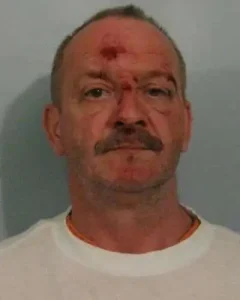William Gibson is a serial killer who was sentenced to death by the State of Indiana for two murders
According to court documents William Gibson is a serial killer an rapist who would be sentenced to death for the murders and sexual assaults of two women: 44-year-old Karen Sue Hodella and 35-year-old Stephanie Marie Kirk
Following the murder of Stephanie Marie Kirk William Gibson mother died and a seventy five year old friend of his mother would come over to comfort him. William would lose his temper and would sexually assault and murder the woman
William Gibson would be arrested, convicted and sentenced to death for two of the murders. For the third murder he was given a life sentence
William Gibson has told authorities that he is responsible for at least 25 murders
William Gibson Photos

William Gibson FAQ
Where Is William Gibson Now
William Gibson is incarcerated at Indiana State Prison
William Gibson Case
The Indiana Supreme Court has denied an appeal for a New Albany man on death row for two of his three murder convictions in Floyd County.
The court ruled that trial counsel was not ineffective and there was no conflict of interest with counsel for convicted serial killer William Clyde Gibson III. The unanimous ruling of four justices, with one additional justice not participating, was handed down Thursday.
Gibson was convicted by a Floyd County jury for the April 2012 murder and post-death mutilation of his late mother’s best friend, 75-year-old Christine Whitis. Gibson pleaded guilty to the March 2012 murder of 35-year-old Stephanie Kirk, who was found buried in the back yard of his New Albany home. He also pleaded guilty to the 2002 murder of Karen Hodella, a case that had gone unsolved since police found her decomposed body in early 2003. In the first two cases, he received a death sentence and in the third, he was sentenced to 65 years in prison.
In January, an attorney representing Gibson argued to the Supreme Court that his trial counsel was ineffective due to:
• a delay in legal representation, which led Gibson to make self-incriminating statements to police,
• a delay in assembling a defense team and failure to challenge evidence presented by the State, including the State’s argument against previously sustained brain damage,
• bad advice related to his plea in the Kirk case, and
• a conflict of interest on the part of the counsel, worrying about keeping costs of defending Gibson lower, “placing the financial needs of his office above loyalty to his client,” according to court documents.
The Supreme Court stated in the ruling that the trial court appointed defense counsel to represent Gibson on April 24, 2012, the same day the State charged Gibson with the Whitis murder and four days after he first confessed to police to killing her and Hodella. His lawyer received notification of his appointment two days later and visited Gibson in jail. The ruling states that even if counsel had been arranged earlier, there was no evidence that it would have stopped Gibson from confessing.
“Despite repeated Miranda warnings from police during his initial custody, Gibson never asked to speak with an attorney,” the ruling stated. “And after receiving warnings from both [his attorney] and the trial court, Gibson … persisted in speaking with police and the media about his crimes.”
As for his brain injury, Dr. Victor Matibag, a neurologist, and Dr. Edmund Haskins, a neuropsychologist and expert on traumatic brain injuries, reviewed an MRI of Gibson, saying during trial that they “found no sign of … impairment, concluding that Gibson suffered from bipolar, anti-social personality and borderline-personality disorders,” the ruling stated.
However, Dr. Andrew Chambers testified at the post-conviction hearing that, based on his review of the MRI and other medical records, Gibson suffered from a possible traumatic brain injury in 1991, according to the ruling. Gibson’s counsel argued that had that information been presented at trial, he might have been spared the death penalty.
The Supreme Court disagreed, saying it found “no deficient performance of counsel,” adding that trial counsel had “no reason to question the qualifications of the experts he employed.”
In addressing Gibson’s guilty plea in the Kirk case, the ruling stated that his attorneys outlined the pros and cons of pleading guilty, telling him it’d be “better to take his chances with the Judge” rather than with the jury. The court stated that Gibson did not show that he would have likely opted to go to trial if advised differently. It also stated that he never “indicated the motivations for his guilty plea.”
In the final argument, Gibson said there was a conflict of interest, as his counsel was concerned with keeping costs down for the Floyd County Public Defender’s Office. In the ruling, it quoted trial counsel J. Patrick Biggs as saying he considered himself “morally bound, ethically bound to spend whatever … is reasonable to spend in a capital case.”
“Based on the actual expenditures in representing Gibson and the employment of co-counsel, an investigator, a mitigation specialist, experts, and other consultants, we have little doubt that Gibson received quality representation, not ineffective assistance of counsel prejudicial to his defense,” the ruling stated.
Gibson’s current counsel, Stephen T. Owens, public defender of Indiana, did not return messages seeking comment by press time. Prosecutor Keith Henderson’s office also did not return a message seeking comment by press time.
